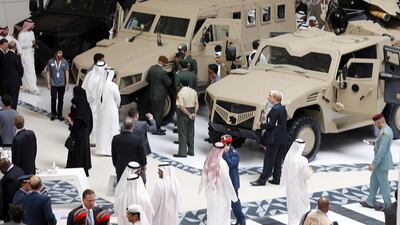DUBAI // The Middle East is one of the most competitive emerging defence markets in the world, a study shows, with demand driven by an increasingly tense geopolitical environment.
The study, by global information company IHS, found the UAE and Saudi Arabia to be the region’s top importers of defence systems, most of which is advanced military aircraft and missiles.
And experts at the IHS Forum in Dubai on Tuesday said the trend would continue.
“Economic prosperity has been one of the reasons behind the rapid acceleration of defence spending in the Middle East since 2011,” said Craig Caffrey, a senior defence budget analyst at IHS Jane’s Aerospace, Defence and Security.
“Four of the top five fastest-growing defence markets in 2013 were Middle Eastern countries and as we look at spending in the next decade there are no signs that the sector is slowing down.
“Between 2014 and 2020, IHS estimates total defence spending in the Middle East and North Africa will be US$920 billion (Dh3.4 trillion).”
By 2020, $27bn is expected to be injected into the Arabian Gulf economy from defence deals, $12.2bn of which will be directed at the UAE, the second-highest in the region after Saudi Arabia.
“The budgets are more robust and stable in the Gulf,” said Tate Nurkin, managing director of consulting and thought leadership at IHS Jane’s Aerospace, Defence and Security.
“The demand for high-end technology is growing and the Gulf is very interested in procuring the best possible technology, which is the top shelf, high-end western or Russian technology in some cases.”
Mr Caffrey said: “Five of the 10 fastest-growing markets are in the Gulf. The region’s defence budgets grew by 12 per cent last year which is a staggering rate and the fastest rate globally. Anywhere that grows more than 5 per cent is already huge.”
The UAE ranked seventh in defence spending and fastest growing budgets last year, with 14.6 per cent. The region was responsible for 30 per cent of all defence imports in 2013.
“Economic growth is a reason and Iran’s always a key aspect as well,” Mr Caffrey said. “A lot of the defence deals have been for missile defence systems for the UAE.
“If there is a major political change in Iran with genuine assurances that the missile programme will be dismantled, it might slow down.”
Spending on defence equipment in the region was valued at $8.2bn last year, with two-thirds delivered to the UAE and Saudi Arabia.
“They dominate the market,” Mr Caffrey said. “Military aircraft represent half the material delivered as well as missiles, which have a significant share.”
Mr Nurkin said most of the money was invested in readiness equipment.
“Resources, the climate and the environment also play a role,” he said. “The fact that there are 7 billion people living in the world is creating security challenges, with less water and food driving conflict, and this affects the defence industry.
“Militaries are prepared to spend lots of money thinking about the harsh environment they will have to deploy to in the future.”
Mr Nurkin said these trends were already playing out and would continue to have implications for the global defence industry.
“The defence and security environments throughout the world are changing and the defence industry is going through a significant transformation,” he said.
“There has been a rebalance over the last three to four years and it is now accelerating.”
cmalek@thenational.ae

